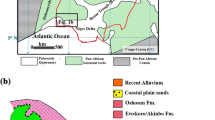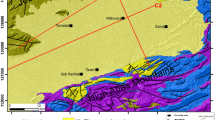Abstract
There is an increasing demand for groundwater vulnerability maps which illustrate the exposure of aquifers against pollution. These maps show areas of greatest potential for groundwater contamination on the basis of local subsurface conditions. Parameters affecting vulnerability are mainly permeability and thickness of each protective layer. For unconsolidated sediments, the permeability is strongly related to the clay content, which can be deduced from indirect resistivity methods, like electrical-imaging. Such geophysical methods can be of great help in groundwater vulnerability studies because they disturb neither the structure nor the dynamics of the soil. Sensibility analysis was performed of the electrical resistivity tomography method for accurately mapping soil media. Managers and public administrators may effectively use this method for assessing the potential risk of groundwater contamination. In the studied zone, electrical resistivity exhibits a wide range of variability that can be easily correlated to soil parameters, such as clay content and hydraulic conductivity. A numerical index of protection has been assessed from the geophysical information derived from 2D electrical resistivity tomography. This work represents a preliminary approach on the natural vulnerability evaluation of shallow aquifers at the Empordà basin (NE Spain) that is highly affected by diffuse pollution by nitrates.






Similar content being viewed by others

References
Aller L, Bennet T, Lehr JH, Petty RJ, Hackett G (1987) DRASTIC: a standardized system for evaluating ground water pollution potential using hydrogeologic settings. US EPA, 600/2-87–035
Anderson LJ, Gosk E (1989) Applicability of vulnerability maps. Environ Geol Water Sci 13:39–43
Bach J (1990) L’Ambient hidrogeològic de la plana litoral de l’Alt Empordà (NE, Catalunya). PhD Thesis, Universitat Autònoma de Barcelona
Dahlin T (1996) 2D resistivity surveying for environmental and engineering applications. First Break 14:275–284
Foster SSD (1987) Fundamental concepts in aquifer vulnerability, pollution risk and protection strategy: In: van Duijvenbooden W, van Waegeningh HG (eds) TNO Committee on Hydrological Research, The Hague, Vulnerability of soil and groundwater to pollutants, Proc Inf 38, pp 69–86
Kalinski RJ, Kelly WE, Bogardi I, Pesti G (1993) Electrical resistivity measurements to estimate travel times through unsaturated ground water protective layers. J Appl Geophys 30:161–173
Kirsch R, Sengpiel KP, Voss W (2003) The use of electrical conductivity mapping in the definition of an aquifer vulnerability index. Near Surf Geophys 1(1):13–19
Loke MH (2002) RES2DINV ver. 3.50. Rapid 2-D resistivity and IP inversion using the least square method. Geotomo Software. Penang, Malaysia. Web address: http://www.geoelectrical.com/contact.html
Loke MH, Barker RD (1996) Rapid least-squares inversion of apparent resistivity pseudosections by a quasi-Newton method. Geophys Prospect 44:131–152
Maillet R (1947) The fundamental equations of electric prospecting, Geophysics 12:529–556
Rupert MG (2001) Calibration of the DRASTIC ground water vulnerability mapping method. Ground Water 39(4):625–630
Author information
Authors and Affiliations
Corresponding author
Rights and permissions
About this article
Cite this article
Casas, A., Himi, M., Diaz, Y. et al. Assessing aquifer vulnerability to pollutants by electrical resistivity tomography (ERT) at a nitrate vulnerable zone in NE Spain. Environ Geol 54, 515–520 (2008). https://doi.org/10.1007/s00254-007-0844-1
Received:
Accepted:
Published:
Issue Date:
DOI: https://doi.org/10.1007/s00254-007-0844-1



